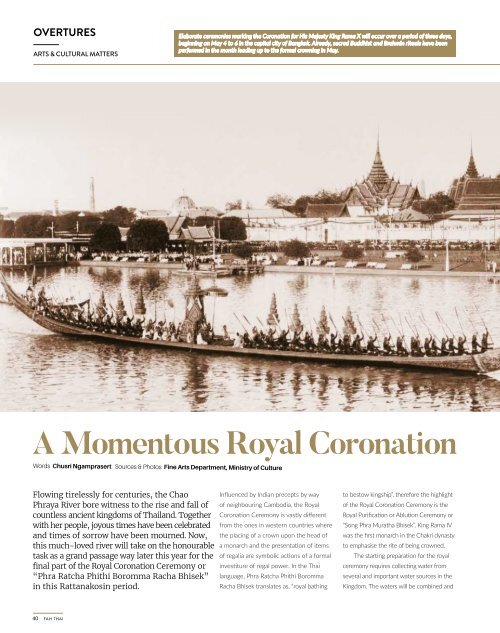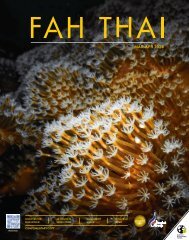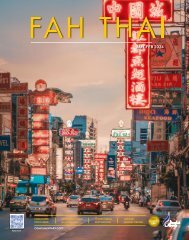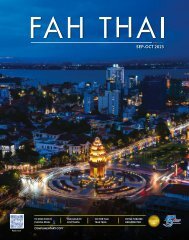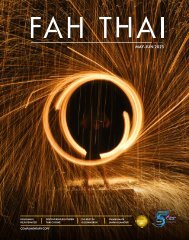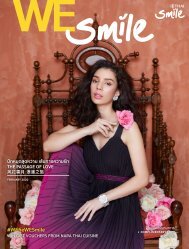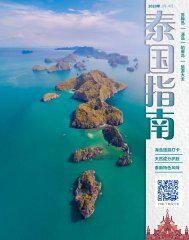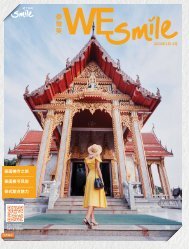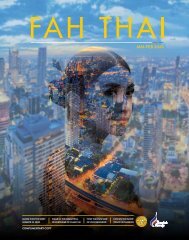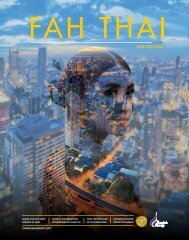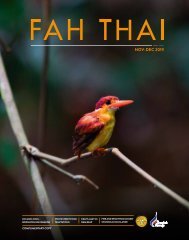Fah Thai Magazine May June 2019
Fah Thai Magazine is an In-Flight Magazine of Bangkok Airways. You can read us at fahthaimag.com
Fah Thai Magazine is an In-Flight Magazine of Bangkok Airways. You can read us at fahthaimag.com
Create successful ePaper yourself
Turn your PDF publications into a flip-book with our unique Google optimized e-Paper software.
OVERTURES<br />
ARTS & CULTURAL MATTERS<br />
Elaborate ceremonies marking the Coronation for His Majesty King Rama X will occur over a period of three days,<br />
beginning on <strong>May</strong> 4 to 6 in the capital city of Bangkok. Already, sacred Buddhist and Brahmin rituals have been<br />
performed in the month leading up to the formal crowning in <strong>May</strong>.<br />
A Momentous Royal Coronation<br />
Words Chusri Ngamprasert Sources & Photos Fine Arts Department, Ministry of Culture<br />
Flowing tirelessly for centuries, the Chao<br />
Phraya River bore witness to the rise and fall of<br />
countless ancient kingdoms of <strong>Thai</strong>land. Together<br />
with her people, joyous times have been celebrated<br />
and times of sorrow have been mourned. Now,<br />
this much-loved river will take on the honourable<br />
task as a grand passage way later this year for the<br />
final part of the Royal Coronation Ceremony or<br />
“Phra Ratcha Phithi Boromma Racha Bhisek”<br />
in this Rattanakosin period.<br />
Influenced by Indian precepts by way<br />
of neighbouring Cambodia, the Royal<br />
Coronation Ceremony is vastly different<br />
from the ones in western countries where<br />
the placing of a crown upon the head of<br />
a monarch and the presentation of items<br />
of regalia are symbolic actions of a formal<br />
investiture of regal power. In the <strong>Thai</strong><br />
language, Phra Ratcha Phithi Boromma<br />
Racha Bhisek translates as, “royal bathing<br />
to bestow kingship”, therefore the highlight<br />
of the Royal Coronation Ceremony is the<br />
Royal Purification or Ablution Ceremony or<br />
“Song Phra Muratha Bhisek”. King Rama IV<br />
was the first monarch in the Chakri dynasty<br />
to emphasise the rite of being crowned.<br />
The starting preparation for the royal<br />
ceremony requires collecting water from<br />
several and important water sources in the<br />
Kingdom. The waters will be combined and<br />
blessed for the Royal Purification Ceremony<br />
and Anointment Ceremony.<br />
According to the ancient Brahmanism<br />
textbook, water for the Royal Purification<br />
Ceremony must come from Pancha Maha<br />
Natee, the five sacred streams in India:<br />
the Ganges, Mahi, Yamuna, Sarayu and<br />
Aciravati, which is believed to flow down<br />
from Mount Kailasa, the abode of Isvara.<br />
Historical records indicate that in the<br />
Ayutthaya period, water for the Royal<br />
Purification Ceremony was collected from<br />
four sacred ponds in Suphan Buri province:<br />
Sa Ket, Sa Kaeo, Sa Khongkha and Sa Yamuna.<br />
In the Rattanakosin period, the water<br />
resources, the sequence and certain details<br />
of the ceremony change in accordance to<br />
what is appropriate in each reign.<br />
From the reigns of King Rama I to<br />
Rama III, water from the Five Virtuous<br />
Rivers known as Bencha Suttha Khongkha<br />
(namely Bang Prakong, Pa Sak, Chao<br />
Phraya, Ratchaburi and Phetchaburi) was<br />
Opposite<br />
The “Suphannahong”<br />
Royal Barge for<br />
His Majesty King<br />
Vajiravudh (Rama<br />
VI) during the<br />
Royal Procession by<br />
Waterway around<br />
the city, for the<br />
occasion of the<br />
Royal Coronation<br />
Ceremony in 1911.<br />
Top Left & Right<br />
King Rama IV’s<br />
Royal Coronation<br />
Ceremony in 1851.<br />
King Rama V’s Second<br />
Royal Coronation<br />
Ceremony in 1873.<br />
added to that collected from the four<br />
sacred ponds in Suphan Buri. King Rama IV<br />
added holy water blessed by the monks<br />
chanting the Phra Paritra Mantra to the<br />
original mixture. Additionally, King Rama V<br />
got sacred water from Pancha Maha Natee<br />
during his trip to India, so it was added<br />
to the holy water in his second Royal<br />
Coronation Ceremony. King Rama VI<br />
instructed that water gets collected from<br />
various sources in the kingdom for his<br />
second Royal Coronation Ceremony. The<br />
water consecration ritual would be done<br />
at the province’s principal temple and then<br />
again at the royal temple.<br />
The Royal Golden Plaque with the<br />
inscription of the King’s official title or<br />
“Phra Suphannabat,” the Royal Golden<br />
Plaque of the Royal Horoscope, the Royal<br />
Seal of State, including pedestals and<br />
venues for the royal ceremony have to be<br />
prepared months ahead. The procession<br />
of the Royal Golden Plaque, the Royal<br />
Horoscope and the Royal Seal of State<br />
starts from the ubosot or main hall of Wat<br />
Phra Sri Rattana Satsadaram, also known as<br />
the Temple of the Emerald Buddha, to the<br />
ceremonial stage at Baisal Daksin Throne<br />
Hall a day before the ceremony.<br />
In the reign of King Rama I, the Royal<br />
Coronation Ceremony took place at the<br />
Indra Bhisek Maha Prasad Throne Hall.<br />
The venue for King Rama II and following<br />
Kings was the Phra Maha Monthira Group,<br />
consisting of the Chakrapat Biman Royal<br />
Residence, the Baisal Daksin Throne Hall<br />
and the Amarindra Vinijaya Mahaisuraya<br />
Biman Throne Hall. King Rama VI was the<br />
only one using the Dusit Maha Prasad Throne<br />
Hall, a replacement of the former Indra Bhisek<br />
Maha Prasad Throne Hall, as a venue for his<br />
second Royal Coronation Ceremony.<br />
Preliminary ceremonies to the Primary<br />
Royal Coronation Ceremony started three<br />
days before the auspicious day. The new<br />
sovereign would give alms to the monks<br />
40<br />
41


